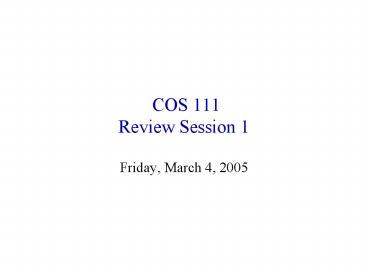COS 111 Review Session 1 - PowerPoint PPT Presentation
Title:
COS 111 Review Session 1
Description:
... one pass over all symbols. So lets note down that fact. One pass ... 41 fourfif one. 42 fourfif two. 43 fourfif three. 44 fourfif four. 100 fiffif ... – PowerPoint PPT presentation
Number of Views:23
Avg rating:3.0/5.0
Title: COS 111 Review Session 1
1
COS 111 Review Session 1
- Friday, March 4, 2005
2
Outline
- All About Numbers
- Boolean/Logic Circuits
- Assignment 4
- Questions
3
Can you say five ?
4
Say five
- Dutch vijf
- German fünf
- French cinq
- Spanish cinco
- Hindi paanch
- Slang -- Lincoln
- Math -- 5
5
Say five
- Dutch vijf
- German fünf
- French cinq
- Spanish cinco
- Hindi paanch
- Slang Lincoln
- Math -- 5
Spoken form
6
Say five
- Dutch vijf
- German fünf
- French cinq
- Spanish cinco
- Hindi paanch
- Slang Lincoln
- Math -- 5
Visual form
7
When is five not five
- When using different langauges
- GM called one of their small cars "Nova". They
didn't sell too many in Spain where 'NoVa' means
doesnt go - Math has many sub-dialects binish, tertiarist,
octalish, hexadecimalish, AnyNish (I am making
the names up but thats not the point ))
8
How much is 10 ?
- You need to know what language it is being spoken
in - V in roman numerals refers to decimal 5 but
refers to decimal 31 in hexatridecimalish - How do we translate from one dialect to another ?
- We need to understand the structure of
math-dialects
9
Closer look at Roman Numerals
- Pick a few agreed upon quantities I, V, X, L,
C, D, M - Express all other numbers as sums and differences
of above 7 is VII, 19 is XIX, 10000 is
MMMMMMMMMM - Not very convenient as numbers become large
- Structure also cumbersome 41 is XLI or IXL
10
Penta System
- Instead of sums and differences, can we use
multiplication to provide structure to number ? - MMMMMMMMMM can be X-M
- But a odd collection I, V, X, L, C, D, M wont do
- Pick 5 symbols 0, 1, 2, 3, 4. Why 5 ?
- Its arbitrary.
- It doesnt matter what the base is as long as its
fixed
11
Lets count
- 0
- 1
- 2
- 3
- 4
- What now ?
- We need to combine our symbols to come up write
bigger numbers
12
Lets count
- 0
- 1
- 2
- 3
- 4
- What now ?
- We have made one pass over all symbols. So lets
note down that fact. One pass and no more.
13
Lets count
- 0
- 1
- 2
- 3
- 4
- 10 lets call this a fif
- We now use position of a symbol in a number to
hold its value.
14
Lets count
- 0
- 1
- 2
- 3
- 4
- 10
10 fif 11 fif one 12 fif two 13 fif
three 14 fif four 20 -- twofif
15
Lets count
- 0
- 1
- 2
- 3
- 4
- 10
10 11 12 13 14 20
20 21 22 23 24 30
30 31 32 33 34 40
40 fourfif 41 fourfif one 42 fourfif
two 43 fourfif three 44 fourfif four 100
fiffif
We now use position of a symbol in a number to
hold its value
16
Penta System
- A number ABCDE is hence
- A fif-fif-fif-fif
- B fif-fif-fif
- C fif-fif
- D fif
- E
- Afif4 Bfif3 Cfif2 Dfif E
17
b System
- A number Xk-1.X0 in base b is
- Sum of Xi-1bi for i from 0 to k-1
- All rules of multiplication, addition,
subtraction are similar to what we normally do in
base 10 numbers
18
Lets do some practice
- Conversion from one base to another
- Subtraction, addition, multiplication in any base
- Suggest numbers and operations and we work it out
together.
19
Before we move to next topic
- Old number systems joke
- Why is Christmas like Halloween ?
- Because 31 oct 25 dec
20
Outline
- All About Numbers
- Boolean/Logic Circuits
- Assignment 4
- Questions
21
Boolean Algebra
- Shorthand for writing and thinking about logic
circuits - Notation
- ' is a NOT
- . is an AND
- is an OR
- 1 represents TRUE
- 0 represents FALSE
22
Some simple rules
- (A ') ' A
- (A ' A) 1
- A 0 A
- A 1 1
- (A '.A) 0
- A.0 0
- A.1 A
- A A A
- A.A A
23
Distributive Laws
- E (E1.E2...En) (EE1).(EE2)...(EEn)
- E.(E1E2...En) (E.E1) (E.E2)... (E.En)
24
DeMorgans Laws
- (E1 E2 ... En)' E1'.E2'....En'
- (E1.E2...En)' E1' E2' ... En'
25
Lets try some examples
- x'.y x.y x
- x.y.z x'.y.z x'.y'.z x'.y'.z x.y'.z'
x.y'.z - x'.y x'.y' x.y' x.y
26
Outline
- All About Numbers
- Boolean/Logic Circuits
- Assignment 4
- Questions

